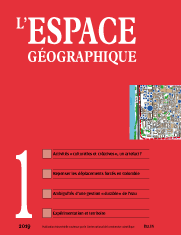

Territorialised or without commitment: An in-depth analysis of cultural and creative activities in a post-industrial neighbourhood in Grenoble (1 encadré, 2 fig., 4 photos)
In the context of fusion of cultural and economic spheres, cultural and creative activities are increasingly seen as a homogenous whole despite persistent differences. In order to examine the relevance of this classification, this paper aims to examine the spirit of cultural and creative workers behind their participation in the social life of the urban neighbourhoods where they spatially agglomerate. Based on the research carried out in the post-industrial district of Berriat in Grenoble, an analysis of the cultural and creative workers’ actions and networks leads to two distinct categories. Linked by common characteristics and a similar attachment to their neighbourhood, cultural workers on one hand and creative workers on the other are distinguished by the relations that they have with their home territory.
keywords: ART, CREATIVITY, CULTURE, NEIGHBOURHOOD, WORKER
Urban transposition of forced displacement in Colombia: Spatialisation, catégorisation and transformation of migration dynamics (2 fig.)
In Colombia, forced displacements of communities constitute a complex migration dynamics. Linked to the war exercise, this form of involuntary mobility is characterised by its devastating scope in terms of space and time. In response to the extent of this phenomenon, the government has implemented compensation policies for the victims of these forced evictions. Indeed, forced displacement leads to a change of residence, which alters their lifestyle. In most cases, the victims choose to settle in the country’s big cities because media attention on the phenomenon tends to present these in the collective psyche as places preserved from any form of armed conflict dynamics. However, patterns of forced population displacement have been observed in Colombian cities also. Building on fieldbased research carried out in Saocha’s Comuna 4, this article examines the ties that bring together as well as distinguish urban and rural patterns of this type of forced mobility.
keywords: COLOMBIA, MIGRATION, RESIDENTIAL MOBILITY
Space and water, key factors or urban growth in the South-Western United States: Case study of Tucson and Pima County (Arizona) (4 fig., 3 tabl.)
Urban sprawl is one of the most important factors of landscape transformation in the United States. The Southwestern region, especially the state of Arizona, is often viewed as a example of this phenomenon in which significant quantities of space and water are consumed. The city of Tucson and the Pima County, where it is located, seem to be a counter-model in this respect since they have been trying to dissociate themselves from the ‘‘growth at all costs’’ model since the 1980s. Based on the statistics and spatial data available on this area, this paper compares Tucson’s declared aims and the reality of its spatial development. Crossing data from different sources, we are able to highlight not only some successes pertaining to water resource management, but also the difficulties that the authorities face in monitoring the transformation of the landscape and the urbanization, as well as resulting imbalances which will prove difficult to rectify in the medium or long term.
keywords: URBAN GROWTH, URBAN SPRAWL, USA, WATER MANAGEMENT
Experimentations in geography and planning: What do they tell, what do they do? (6 fig.)
Space, place and their inhabitants are now subjected to a whole range of experimentations. There is however a surprising paradox: On one hand, the specificity of social sciences would be that “fieldwork” is supposed to have replaced “experiments”; on the other hand, funding requests, papers and dissertations increasingly emphasise their “experimental” scope. So is it just a matter of ease of language? Or does institutional and funding pressure force us to trump up the ways to present research and innovation? Politicians promote experimentation in order to don a scientific aura, but are we not running the risk of making it an end in itself? Or is this paradox the symptom of a new horizon?
keywords: EXPERIMENT, EXPERIMENTATION, GEOGRAPHY, SPATIAL PLANNING, TERRITORIES, URBAN PLANNING
Book reviews
In this issue of l’Espace géographique, you will find critical reviews of the following books
SANDERS L. (dir.)(2017). Peupler la Terre. De la préhistoire à l’ère des métropoles. Tours: Presses universitaires François Rabelais, coll. «Villes et territoires», 528 p. (Yves Guermond, université de Rouen, UMR 6266 IDEES) ISBN: 978-2-86906-494-2
FAU N., TRÉGLODÉ B. DE (dir.)(2018). Mers d’Asie du Sud-Est: coopérations, intégrations et sécurité. Paris: Cnrs Éditions, 400 p. (Michel Bruneau, CNRS Bordeaux) ISBN: 978-2-271-12320-6
MOUSSAÏD M. (2019). Fouloscopie. Ce que la foule dit de nous. Paris: HumenSciences Éditions, 224 p. (Jean-Christophe Gay, IAE de Nice, université Côte d’Azur) ISBN: 978-2-379-31014-0
JENSEN P. (2018). Pourquoi la société ne se laisse pas mettre en équations. Paris: Le Seuil, coll. «Science ouverte», 336 p. (Denise Pumain, université Paris 1 Panthéon-Sorbonne) ISBN: 978-2-02-138011-8
L’espace géographique 4/18![]()
![]() L’espace géographique 2/19
L’espace géographique 2/19
For subscribe or buy this issue: BELIN
![]() L’Espace géographique: contents
L’Espace géographique: contents
Last modified: December 15, 2019